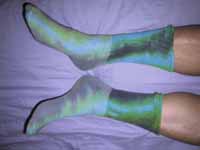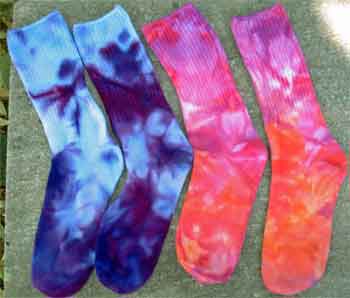I am having a lot of problems tie dying socks
Name:
Jean
Region: New Jersey, USA
Message: I am having a lot of problems tie dying socks. The bands on the socks come out great but the rest of the sock fades, or other colors pull out of the one that I put on. Ex: black - I have blues, etc.separating from the black. Again, color on sock is faded but band is beautiful. What am I doing wrong? Is it the material content of the sock? They have about 83-84% cotton in them. Thx for your help.
What kind of dye are you using? That is, what brand is it? Is it Rit dye, or a Tulip tie-dye kit, or what?
It's the Jacquard Procion MX. I soak in soda ash for 30 mins., squeeze out then lay socks flat and squirt with bottle on socks, let sit for a few hours (but you can see the color changing as it sits), wash and that's it.
Okay, that is a good choice of dye, and it looks like the right technique, so the problem is the socks that you're dyeing.

Unlike most fiber blend garments, socks often have their synthetic-fiber components more visible in one part of the sock than another. Th 16% or so of the fiber blend that is nylon, acrylic, polyester, and/or spandex is what's not holding on to the dye, in your socks.
It's never practical to try to dye the spandex portion of a spandex blend garment. The circumstances required to dye spandex can ruin the shape of the garment. With socks, it's best to either accept the lighter-colored portions as they are, or find a different source for socks which don't have as much visible synthetic fiber.
To the upper left is an example of some socks I dyed that had an excessive amount of synthetic fiber on the surface of the foot portion. Is that what's happening to your socks? In contrast, the second picture, below left, is an example of socks from a different source, which dye much more nicely.
With the latter socks, the only time you can see any undyed synthetic fiber at all is when they are fully stretched, and then only in the top portion of the socks, but even then the overall effect is one of bright colors, with a few white threads showing.

The socks in my second picture, below left, are the adult bamboo socks that are sold by Dharma Trading Company. Bamboo is a cellulose fiber, actually a form of rayon; it feels comfortable like cotton, and dyes even more beautifully than cotton. As of this writing, Dharma is still selling these socks, and they are very reasonable in price, so I recommend you order some from them. The bamboo socks are available in sizes for adult men and women as well as for children.
Another source of socks that have dyed beautifully for me is the company Maggie's Organics. I've had excellent results dyeing both cotton and hemp socks from this company. Unfortunately, the cost of the socks tends to be much higher, but they are durable.
Socks from other sources, such as Target or Walmart, will usually dye pretty well, if they are at least 80% cotton (watch out for the mostly-acrylic or polyester socks, which are no good for dyeing!), but they are not as satisfactory for dyeing as the bamboo socks from Dharma or the socks I've gotten from Maggie's Organics. If you're going to spend the time to dye socks, it's worth going to the trouble of buying high-quality sock blanks.
Not all the socks Dharma sells dye equally well. Some organic cotton socks I bought from Dharma dyed like the first example picture above. The product description in the catalog was clear in warning that this would happen, however, so it was not a big problem.
The above explains why the band portion of your sock is dyeing well but the foot portion is not. It has nothing to do with the fact that some of your colors are separating from one another. It is normal for any dye that is a mixture of two or more colors, such as the black dye you're using, to separate out into different colors when you paint it on. In order to prevent your color mixtures from separating, you will need to buy a thickener for your dye. See my page, "Sodium alginate, Superclear, and other dye thickeners". The most popular dye thickener for Procion MX dye is sodium alginate. It is commonly use in tie-dyeing to keep the dyes from spreading and blending on the fabric. You can mail-order sodium alginate from your dye supplier, such as Dharma Trading Company or Jacquard Products.
Another approach to preventing Procion MX colors from separating out is to use the pure unmixed dye colors. These are listed, for various dye suppliers, on my chart of "Which Procion MX dyes are pure, and which are mixtures?". There is no single-hue unmixed black in the Procion MX line. When I want a black that absolutely will not separate out, I use a different fiber reactive dye, the Remazol reactive black 5. You can buy the Remazol Black 5 from Joann's fabric stores in the form of Dylon Permanent 12 black, or from PRO Chemical & Dye as their Liquid Reactive Black. This is only for dye fanatics, though, I think; dye thickeners will probably meet your needs just fine.
(Please help support this web site. Thank you.)
Region: New Jersey, USA
Message: I am having a lot of problems tie dying socks. The bands on the socks come out great but the rest of the sock fades, or other colors pull out of the one that I put on. Ex: black - I have blues, etc.separating from the black. Again, color on sock is faded but band is beautiful. What am I doing wrong? Is it the material content of the sock? They have about 83-84% cotton in them. Thx for your help.
What kind of dye are you using? That is, what brand is it? Is it Rit dye, or a Tulip tie-dye kit, or what?
It's the Jacquard Procion MX. I soak in soda ash for 30 mins., squeeze out then lay socks flat and squirt with bottle on socks, let sit for a few hours (but you can see the color changing as it sits), wash and that's it.
Okay, that is a good choice of dye, and it looks like the right technique, so the problem is the socks that you're dyeing.

Unlike most fiber blend garments, socks often have their synthetic-fiber components more visible in one part of the sock than another. Th 16% or so of the fiber blend that is nylon, acrylic, polyester, and/or spandex is what's not holding on to the dye, in your socks.
It's never practical to try to dye the spandex portion of a spandex blend garment. The circumstances required to dye spandex can ruin the shape of the garment. With socks, it's best to either accept the lighter-colored portions as they are, or find a different source for socks which don't have as much visible synthetic fiber.
To the upper left is an example of some socks I dyed that had an excessive amount of synthetic fiber on the surface of the foot portion. Is that what's happening to your socks? In contrast, the second picture, below left, is an example of socks from a different source, which dye much more nicely.
With the latter socks, the only time you can see any undyed synthetic fiber at all is when they are fully stretched, and then only in the top portion of the socks, but even then the overall effect is one of bright colors, with a few white threads showing.

The socks in my second picture, below left, are the adult bamboo socks that are sold by Dharma Trading Company. Bamboo is a cellulose fiber, actually a form of rayon; it feels comfortable like cotton, and dyes even more beautifully than cotton. As of this writing, Dharma is still selling these socks, and they are very reasonable in price, so I recommend you order some from them. The bamboo socks are available in sizes for adult men and women as well as for children.
Another source of socks that have dyed beautifully for me is the company Maggie's Organics. I've had excellent results dyeing both cotton and hemp socks from this company. Unfortunately, the cost of the socks tends to be much higher, but they are durable.
Socks from other sources, such as Target or Walmart, will usually dye pretty well, if they are at least 80% cotton (watch out for the mostly-acrylic or polyester socks, which are no good for dyeing!), but they are not as satisfactory for dyeing as the bamboo socks from Dharma or the socks I've gotten from Maggie's Organics. If you're going to spend the time to dye socks, it's worth going to the trouble of buying high-quality sock blanks.
Not all the socks Dharma sells dye equally well. Some organic cotton socks I bought from Dharma dyed like the first example picture above. The product description in the catalog was clear in warning that this would happen, however, so it was not a big problem.
The above explains why the band portion of your sock is dyeing well but the foot portion is not. It has nothing to do with the fact that some of your colors are separating from one another. It is normal for any dye that is a mixture of two or more colors, such as the black dye you're using, to separate out into different colors when you paint it on. In order to prevent your color mixtures from separating, you will need to buy a thickener for your dye. See my page, "Sodium alginate, Superclear, and other dye thickeners". The most popular dye thickener for Procion MX dye is sodium alginate. It is commonly use in tie-dyeing to keep the dyes from spreading and blending on the fabric. You can mail-order sodium alginate from your dye supplier, such as Dharma Trading Company or Jacquard Products.
Another approach to preventing Procion MX colors from separating out is to use the pure unmixed dye colors. These are listed, for various dye suppliers, on my chart of "Which Procion MX dyes are pure, and which are mixtures?". There is no single-hue unmixed black in the Procion MX line. When I want a black that absolutely will not separate out, I use a different fiber reactive dye, the Remazol reactive black 5. You can buy the Remazol Black 5 from Joann's fabric stores in the form of Dylon Permanent 12 black, or from PRO Chemical & Dye as their Liquid Reactive Black. This is only for dye fanatics, though, I think; dye thickeners will probably meet your needs just fine.
(Please help support this web site. Thank you.)
Posted: Sunday - January 24, 2010 at 10:07 AM
Follow this blog on twitter here.
Quick Links
- All About Dyes & Dyeing Top -
- Top of this blog -
- FAQ -
- The Dye Forum -
- How to Tie Dye - How to Batik -
- Books - Toys - Plants -
- Top of this blog -
- FAQ -
- The Dye Forum -
- How to Tie Dye - How to Batik -
- Books - Toys - Plants -
More in this category:
- -
Statistics
Total entries in this blog:
Total entries in this category:
Published On: Aug 29, 2012 02:48 PM
Total entries in this category:
Published On: Aug 29, 2012 02:48 PM